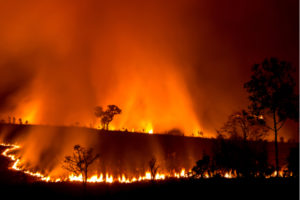
This week, BlackRock CEO Larry Fink told investors that his company, the world’s largest asset manager, will make “sustainability”–corporate code for climate change reactionism–the “new standard for investing.”
Holman W. Jenkins explains in The Wall Street Journal that the climate change hysteria surrounding weather phenomenon like the Australian and Californian forest fires is misplaced. He writes:
What about Australia’s and California’s wildfires? Some won’t want to hear it, but climate policy is not a solution for the problems of forest management, especially the need for controlled burns to reduce the fuel build-up that leads to catastrophic conflagrations. Though currently it’s the practice to string up on Twitter anybody who mentions this, some tactless insurance-industry types insist on noting that a large part of the problem is independent of a warming climate.
Happily, the data are encouraging here too. News reporters may be confused by the rising disaster bills seen when more people and buildings are placed in the path of predictable hazards. But as a widely cited study last year pointed out, global mortality and economic loss from natural hazards experienced by the average human being have actually fallen by a factor of five since 1980. Why? Because of the same rising global wealth that activists are starting to understand is also associated with a moderating path of future emissions.
Jenkins notes that some improvement may be occurring in the discussions over climate change. He writes:
And yet the zeitgeist, I think, is changing (and I like to think this column played a role). “Denier” is getting a last go-round in Australia at the hands of some whose wrong-footedness is their most salient quality, but the term is increasingly recognized as a sleazy way to refer to people whose views are perfectly compatible with the lower-end estimates of the U.N.’s Intergovernmental Panel on Climate Change.
Then there’s this: David Wallace-Wells, author of last year’s “Uninhabitable Earth,” a jeremiad so extreme that it was praised by reviewers even as it was panned by climate scientists, wrote a column in New York magazine saying, in so many words, never mind. He discovers “deep—perhaps fatal—problems” with the worst-case emissions projection (known as RCP 8.5) that underlies most “business as usual” climate scenarios. He says fellow activists need to revise their “understanding in a less alarmist direction.”
No kidding, as readers of this column already know, including a column last year about the Trump administration’s effort to correct the U.S. government’s own sorry habit of peddling climate policy with far-fetched worst-case scenarios.
In reality, the path of emissions most consistent with historical economic, technological and demographic trends is RCP 4.5—the second-best scenario. Notice that it’s a much smaller jump from RCP 4.5 to the best-case scenario of RCP 2.6 than to RCP 8.5, which posits a near collapse of the global economy and a world that burns an implausible six times as much coal as today. Sure enough, the latest data confirm that, outside China, global emissions were flat in 2019 and the world overall remains on track for the second-best scenario.
Read more here.



